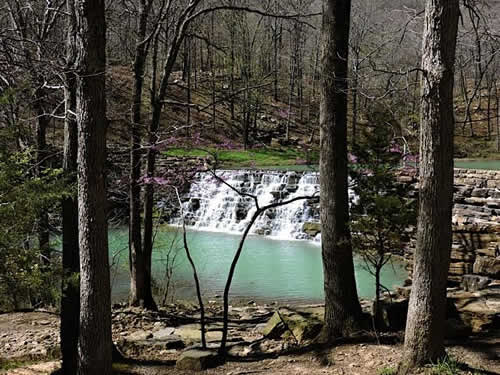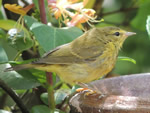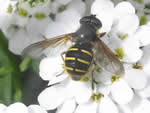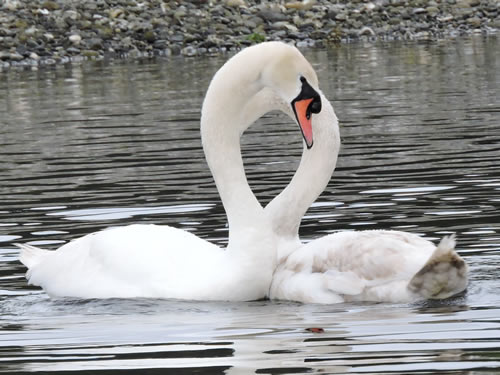 ___ ___
Welcome to our monthly celebration of nature and photography!
THIS MONTH:
» How well do you know your state and provincial birds? See this month's quiz!
» Five Things About... Elk
» Comparing Bird Feet!
|
|
 |
Like golf balls on stems, the Wind flower, Anenome multifida, greets
you
this month as spring heralds in the lovely season of wildflowers.
|
Where's Lily?
While you're reading this month, be sure to keep an eye out for Lily the Ladybug.
She's managed to hide in one of the photos, but which one?! |
 |
|
|

Which North American animal can sleep for three years of more?
Compare your answer with the answer at the end of the newsletter.
|

 |
Here's a close-up image to test your mystery-solving skills.
As usual, you'll find the answer at the end of the newsletter.
|
|

|
_ |
 |
The Elk is found across western North America and is a large, regal and majestic member of the deer family. |
| |
|
|
| |
 |
One of its the most striking characteristics is its rack of antlers which males grow and shed every year. Each year the new antlers, which are made of bone, have more points. |
| |
|
|
| |
 |
While developing, the antlers are covered in a protective "velvet" which you can see in this image. The velvet is gradually rubbed off. The antlers grow up to 5 ft/1.6 m across and weigh 40 lb/18 kg! |
| |
|
|
| |
 |
Autumn is rutting or mating season for the Elk. Across the mountain valleys you may hear a haunting, magical sound which is the males bugling to attract females. |
| |
|
|
| |
 |
A dominant, powerful male will establish a harem of about 20 cows and stay with them throughout the winter. He will defend and protect his harem from predators and other bulls. |
|
|
Here we go with another matching quiz! Last month the quiz was about state and provincial flowers - but this month we are focusing on state and provincial birds.
So, grab a sheet of paper and make a list 1 through 12 and start matching! Have fun
(Don't worry if you have some birds left over as there are more clues than places.) |
| |
| 1. Alaska |
2. Alberta |
3. British Columbia |
4. Connecticut |
| |
|
|
|
| 5. Hawaii |
6. Minnesota |
7. Montana |
8. New Mexico |
| |
|
|
|
| 9. Utah |
10. Virginia |
11. Washington |
12. Yukon |
|
| |
|
|
|
a. American Goldfinch |
|
b. American Robin |
| |
|
|
|
|
|
c. California Seagull |
|
d. Common Loon |
| |
|
|
|
|
|
e. Common Raven |
|
f. Great Horned Owl |
| |
|
|
|
|
|
g.
Greater Roadrunner
|
|
h. Hermit Thrush |
| |
|
|
|
|
|
i. Nene |
|
j. Northern Cardinal |
| |
|
|
|
|
|
k. Snowy Owl |
|
l. Steller's Jay |
| |
|
|
|
|
|
m. Western Meadowlark |
|
n. Willow Ptarmigan |
| | |
|
|
|
LITTLE HINT: Check out the Bird's Nest Lounge.
|
Many thanks to everyone who submitted some of these images!
|
Quiz answers are found later in this issue of Whispers. |
| |
|

Demonstrate your wisdom and nature know-how by throwing
a few fascinating nature words into your daily conversations!
| I was wandering down by a pond and my friend mentioned that he loved that colourful speculum that he spotted. I realized he was referring to |
| |
a. a pretty reflection on the water. |
| |
b. and interesting butterfly. |
| |
c. something on a duck's wing. |
| |
d. a marsh bird. |
| |
| |
You'll find the answer at the end of this month's Whispers.
|
|

 |
As spring rolls across the continent, you'll be seeing lots of flowers by the roadside. Many people pass these off as weeds, but there is a lovely variety of these underrated plants. This month's featured page is our selection of wayside plants. Check it out here!
|
|
|
|
__ |
|
Joyce Cahill of Winslow, Arkansas, is one of our regular contributors, and snapped this gorgeous picture of an White Ibis with its lovely reflection. |
|
Penny Hershaw of Toronto caught this Little Blue Heron in a spot of sunlight in Mexico. |
| |
|
|
|
|
|
Just before it leapt away, this American Bullfrog was spotted by Tracy Capps of Mascoutah, Illinois. |
|
Tracy was also lucky to have this Mockingbird pose nicely for her! |
| |
|
|
Many thanks to Joyce, Penny and Tracy! We appreciate your wonderful pictures and taking the time to send them in to us.
If you have a nature image you'd like to see in this section, please let us know!.
|
|

|
Our wanderings this month took us down to the sea where we spotted this Double Crested Cormorant that was just about to take off on an adventure. |
|
|

Do you have an idea for a fun caption for this photo?
|
|
Here are some ideas:
#1 - "I bet you can't do this!"
#2 - "Now who turned things upside down?"
If this month's photo inspires you, please send us your caption in an e-mail.
|
|

 |
This beautiful, tranquil scene was captured by Joyce Cahill. It's taken in Devil's Den Park, in her hometown of Winslow, Arkansas. This looks like a wonderful place to spend some quiet time. Thank you, Joyce! |
|
|

___One day, an old coyote was out doing one of his favourite things: chasing rabbits, when he spotted a young cougar heading in this direction.
___He thought, oh no! I'm in deep trouble now!
___Noticing some old bones close by on the ground, he settled down to have a good gnaw, his back to the cat.
___Just as the cougar got close, the coyote shouted out, "Boy, that was one delicious cougar!"
___Hearing this, the young cougar halted his attack. Whew, that was close, he thought. That old coyote nearly had me!
___Meanwhile, watching all this was a sly squirrel who figured he could make a deal with the cougar in exchange for some protections. He scurried along and caught up with the cougar and told him what the coyote had done. The cougar was furious! No one makes a fool of him!
___"Here, squirrel, hop on my back and you'll see what's going to happen to that tricky coyote!"
___As he saw the cougar coming along the trail with the squirrel, the coyote started to wonder what he could do to get out of this fix.
___
Thinking quickly, he soon sat down with his back to his attackers, pretending he hadn't seen them. Just when they got close enough to hear, the crafty coyote said loudly, " Where's that squirrel? I sent him off an hour ago to bring me another cougar!"
|
|
|
"I think it's time to leave. Don't want to push my luck!" |
| |
|

Here are this month's choices:
Bird - Orange-crowned Warbler | Wildflower - Desert Dandelion | Bug - Hoverfly
 __ __  __ __
Click on the images to visit the pages.
| News |
|
We are redesigning some of the pages of the Inn!
We hope that
the
changes will help you get around a bit easier.
This is the new Wildflower Garden Page.
|
| |
Tips and Ideas |
|
This month's tip is inspired by the holes drilled by this Red-naped Sapsucker. |
| |
|
If you make a few rows of 5/16-inch hole in blocks of wood, they are excellent spots for Orchard Bees to lay their eggs. Orchard Bees are spectacular pollinators! |
| |
Picture of the Week
 |
|
Be sure to drop by the Inn every week to see the latest Picture of the Week.
You can also do so by clicking on the image to the left or by clicking here. |
|
| |
|
| |
Past Issues
If you want to see any of the past issues of Whispers, they are available here.
|
|

|
Celebrate World Migratory Day on Saturday, May 14!
Click here for some more information and details. |
| |
|

 |
Did you know that boiled and dried Rough Horsetail, Equisetum hyemale, is used as a traditional polishing material in Japan? It has a finer grit than any sandpaper and even has another common name: Scouring Rush! |
|
|

 |
North Dakota has an official state fruit: Black Chokecherry, Prunus virginiana. |
| |
|

|
It's believed that some snails can hibernate for up to six years! |
|
|

 |
Our close up image is a delightful pair of two courting Mute Swans.
How close was your guess?
|
| |
|

|
A speculum is
c. something on a bird's wing.
You can see the colourful glistening blue speculum on this lady Mallard. |
| |
|
|
|
|
|
|
1. Alaska - n. Willow Ptarmigan |
|
2. Alberta - f. Great Horned Owl |
| |
|
|
|
|
|
3. British Columbia - l. Steller's Jay |
|
4. Connecticut - b. American Robin |
| |
|
|
|
|
|
5. Hawaii -
i. Nene |
|
6. Minnesota - d. Common Loon |
| |
|
|
|
|
|
7. Montana -
m. Western Meadowlark |
|
8. New Mexico -
g. Greater Roadrunner |
| |
|
|
|
|
|
9. Utah - c. California Seagull
|
|
10. Virginia - j. Northern Cardinal |
| |
|
|
|
|
|
11. Washington - a. American Goldfinch |
|
12. Yukon - e. Common Raven |
| |
|
|
|
The Leftovers (in case you were wondering) |
|
|
|
Quebec - Snowy Owl |
|
Vermont -
Hermit Thrush |
|
|
|
Be sure to have a look at our page of state and provincial birds. Click right here!
A few notes of interest:
Northern Cardinal - As well as Virginia, the Northern Cardinal is the state bird of Illinois, Indiana, Kentucky, North Carolina, Ohio and West Virginia.
American Robin – The American Robin is the state bird of Connecticut, but also been chosen by Michigan and Wisconsin.
The Western Meadowlark is also a popular choice. As well as Montana, it’s also the state bird of Nebraska, North Dakota, Oregon and Wyoming. |
| |
|
|
|
 |
Still looking for Lily?
If you need a little clue, click here! |
|
Thanks for joining us this month! We hope you enjoyed this issue of Whispers. We invite your comments and ideas - just drop us an e-mail. See you next month! |
|